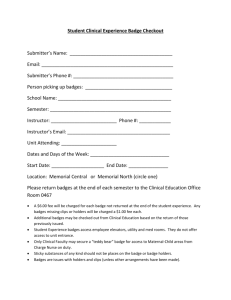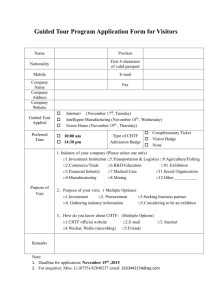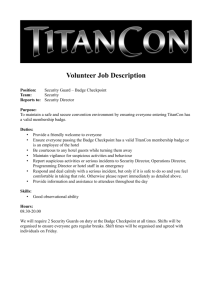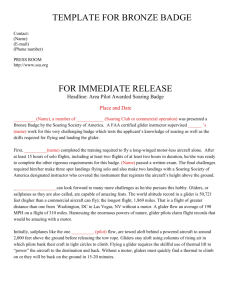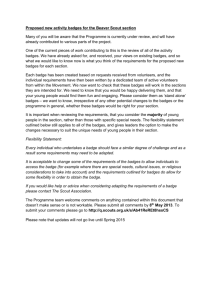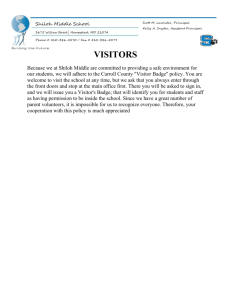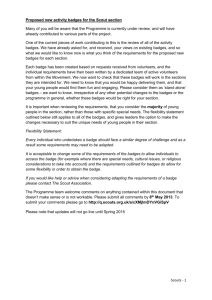Cub Scout section
advertisement
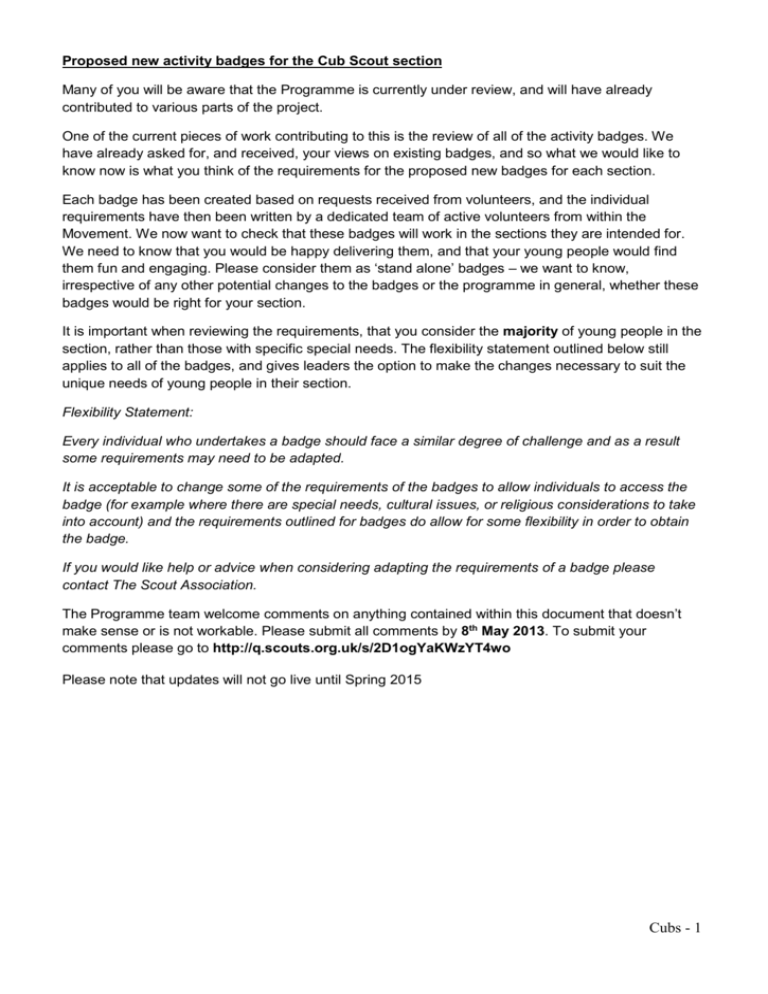
Proposed new activity badges for the Cub Scout section Many of you will be aware that the Programme is currently under review, and will have already contributed to various parts of the project. One of the current pieces of work contributing to this is the review of all of the activity badges. We have already asked for, and received, your views on existing badges, and so what we would like to know now is what you think of the requirements for the proposed new badges for each section. Each badge has been created based on requests received from volunteers, and the individual requirements have then been written by a dedicated team of active volunteers from within the Movement. We now want to check that these badges will work in the sections they are intended for. We need to know that you would be happy delivering them, and that your young people would find them fun and engaging. Please consider them as ‘stand alone’ badges – we want to know, irrespective of any other potential changes to the badges or the programme in general, whether these badges would be right for your section. It is important when reviewing the requirements, that you consider the majority of young people in the section, rather than those with specific special needs. The flexibility statement outlined below still applies to all of the badges, and gives leaders the option to make the changes necessary to suit the unique needs of young people in their section. Flexibility Statement: Every individual who undertakes a badge should face a similar degree of challenge and as a result some requirements may need to be adapted. It is acceptable to change some of the requirements of the badges to allow individuals to access the badge (for example where there are special needs, cultural issues, or religious considerations to take into account) and the requirements outlined for badges do allow for some flexibility in order to obtain the badge. If you would like help or advice when considering adapting the requirements of a badge please contact The Scout Association. The Programme team welcome comments on anything contained within this document that doesn’t make sense or is not workable. Please submit all comments by 8th May 2013. To submit your comments please go to http://q.scouts.org.uk/s/2D1ogYaKWzYT4wo Please note that updates will not go live until Spring 2015 Cubs - 1 Cub Activity Badge: Backwoods Cooking 1. 2. 3. 4. 5. 6. Demonstrate how to light a fire Help prepare a fire for cooking on Cook something using a billy can Cook something in the embers of a fire Cook something on a stick Show how to make the fire safe when you have finished with it. Cub Activity Badge: Disability Awareness This badge can be carried out within the Pack, or as an individual To achieve the badge, the Cub must complete 6 activities, with at least 1 from each area. 1. Disability Awareness What is disability and how can it affect daily life? Find out about 2 disabilities Choose and talk about a Paralympian and their sport. Design a poster showing how your meeting place could be improved for everyone to take part. 2. Physical disability awareness Talk about aids that can assist a disabled person, including wheelchairs, computers, grabbers, rising chairs, adapted cars Know three ways to make it easier for a wheelchair user to use public places, like shops, parks, hospitals or libraries. Describe how your meeting place could be improved for a wheelchair user. Design and play a game where you can only sit down or use one hand ie Goal Ball. 3. Deaf awareness Learn the finger-spelling alphabet. Learn the promise in British Sign Language Explain what hearing dogs for deaf people do and why they are helpful. Explain what equipment is available for a deaf person in the home, (fire alarms, telephones, subtitles) Show how to: - approach a deaf person - speak to a deaf person so they can lip-read. Design and play a game without using sound. 4. Sight awareness Find out about the different ways a blind or visually-impaired person can read, for example using the computer, Braille or Moon. Explain what guide dogs for blind people do and how they are trained. Learn and identify your name in Braille. Guide a blindfolded beaver through a game/assault course Show how to approach and identify yourself to a blind or visually impaired person. Play blind football Guidance: Need some help? Here are some useful websites to get you started Cubs - 2 Action on Hearing Loss (previously RNID) catalogue National Deaf Children's Society (NDCS) Royal National Institute of Blind People (RNIB) Whizz-Kidz British Sign Language Guide Dogs http://www.deafbooks.co.uk/Learn-BSL-British-Sign-Language-Beaver-Promise-AWWI8-aspx www.scope.org.uk http://www.goalballuk.com/ http://www.omniglot.com/writing/braille.htm http://www.paralympics.org.uk/ http://www.autism.org.uk/ http://www.sense.org.uk/ Cub Activity Badge: Environment To gain this badge, Cub Scouts must complete the following: 1. Know how to separate rubbish between recyclable and non recyclable ready for collection. Know where to take items that cannot be collected with your normal rubbish but can still be recycled. 2. Know how to reduce energy and water use in the home – show how you have encouraged your family to reduce water and energy use over a 4 week period. 3. Find out about one form of renewable energy. Discuss with a leader the advantages and disadvantages of the technology. 4. Find out about a project in your local area that helps to improve the environment. If possible visit the project and talk to the people involved in it. Either take part in the project or design a poster showing people what the project is about and how it will improve the environment. Cub Activity Badge: Fire Safety Either: 1. Visit a Fire Station or invite a Fire-fighter at your meeting place. OR 2. Learn about some of the other things that fire-fighters do (e.g. road traffic accidents, rescue operations, smoke detector fitting, safety inspections at homes, schools and workplaces). Complete 5 of the following: Learn about how to make a call to the emergency services and find out what information they need to respond quickly to any incident. Take part in a fire drill at your meeting place and learn what you should do if a fire breaks out. Make an emergency escape plan for your home. Know the importance of smoke and heat detectors. Identify 3 possible dangers at home or your meeting place that could start a fire. Know how a fire at camp should be kept safe for everyone and what safety precautions should be taken. Know how to behave around a bonfire and fireworks. Cubs - 3 Cub Activity Badge: Pioneer 1. Build an indoor pioneering project using canes and elastic bands or simple knots and lashings 2. Demonstrate the following 3knots one to be the shoelace knot 1 hitch 3. With help tie a simple lashing 4. Using a rope machine make your own rope 5. Take part in a knot game Cub Activity Badge: Woodworker 1. Show the safe use of, and how to take care of, tools such as a hammer, a saw, a screwdriver, a drill, a glue gun etc. 2. Discuss with a leader how to work safely on your projects especially if using electric tools 3. Understand the difference between hard wood, soft wood, chipboard, plywood and MDF and know their suitability for different projects. 4. Under adult supervision, help design and make two items which demonstrate the following skills (suitable items might include a nesting box, window box, a box for storing tools, pencils, tapes, etc, a rack for keys, mugs or coats, book-ends or a bookstand,) a. Accurate measurement b. Sawing c. Two different ways of joining pieces of wood together d. Use of a drill, hammer and screwdriver e. Surface preparation and staining, varnishing or painting Staged Activity Badge: Air Activities Stage 1 1. Make a paper dart out of paper and see how well it flies. 2. Find out about a particular aeroplane and tell others in the Colony about it. Examples might be Concorde, Spitfire, Airbus, Lynx helicopter etc. 3. Talk to someone who has flown in a plane, helicopter or hot air balloon and find out what it was like. 4. If you have already flown in a plane, tell others in the Colony what it was like. If not, tell them what you would like to fly in, and why. Stage 2 1. Know the dangers involved in visiting an airfield. 2. Visit an airfield, air display or air museum. 3. Choose three of the following: a. Make and fly one of the following: a model aeroplane, three different types of paper glider, a hot-air balloon, or a kite. b. Identify six airlines from their markings. c. Name and identify the main parts of an aeroplane. d. Assemble a plastic scale model aeroplane to a reasonable standard. Cubs - 4 e. f. g. h. Name and identify the different types of aircraft (powered aeroplanes, airships, gliders etc). Fly in an aircraft and share their experience with the Pack. Explain how different weather conditions can affect air activities. Collect and identify six different pictures of aircraft and share them with other Cub Scouts. Stage 3 1. Know the rules relative to access of an airfield as described in the factsheet xxx. Draw a diagram/make a model of an airfield to show and name different points. 2. Understand the terms – nose, fuselage, tail, wings, port, starboard, tail fin. Know the names of control surfaces. 3. Construct and fly a chuck glider for at least 5 seconds, or build and fly a hot air balloon or kite. 4. Choose one of the following activities: a. Collect photographs or pictures of six aircraft that interest you, name them and their operational uses. b. Discuss an airline that you are interested in, or have travelled on, showing pictures of aircraft livery and logos. 5. Take part in a Patrol or Troop visit with other Scouts to a place of aviation interest. 6. Communicate with someone/spell your name using the phonetic alphabet. Explain why it is used. 7. Demonstrate how to get a weather forecast for an air activity. 8. Using 1:50000, 1:25000 OS maps, show you understand meaning of scale and common map symbols. Stage 4 1. Hold Stage 3. 2. Demonstrate ability to trim a model glider to perform a straight glide, stall and turn. Name the main control surfaces of an airplane and how they work. 3. Identify 12 aircraft in use today from pictures or in flight. These must include at least two civil commercial aircraft, two military aircraft and two light private aircraft. 4. Explain how wind speed and direction are measured, how weather can affect air activities. 5. Demonstrate examples of the ground to air emergency code. 6. Show how to perform a pre-flight check on a light aircraft, micro-light or glider and explain why inspection of each part is important. 7. Choose one of the following activities: a. Fly in a light aircraft or glider as a passenger and know the rules in Policy, Organisation and Rules relating to flying. b. Help to organise a visit to an airfield or place of aviation history for a group of Scouts. Explain to your assessor what you would need to tell the Scouts prior to the visit. 8. Know the common air charts and the conventional signs used on them. 9. Demonstrate a take off and landing using a home flight simulator computer programme that uses a joystick. 10. Draw a runway and its circuit patterns. Stage 5 1. Hold Stage 4. 2. Explain the relationship between lift, drag, thrust and weight. 3. Choose one of the following two activities: Cubs - 5 4. 5. 6. 7. 8. 9. a. Explain the duties of an aircraft marshaller and demonstrate marshalling signals. b. Explain the duties of a crew leader for a glider launch and demonstrate procedure and signals. For a cross-country flight of at least 60 nautical miles, work out the time of flight from an overhead starting point to an overhead destination for 90 knots air speed assuming a given head or tail wind. Choose one of the following activities: a. Explain the basic principles of a piston engine, including the four-stroke cycle, with consideration of valve and ignition timing. b. Compare and contrast the main parts and workings of a piston engine and a jet engine. Explain how wind is used in take off and landing. Explain how a wing gives lift and why a wing stalls. Build a scale model to a satisfactory standard from a plastic kit, plans or photographs. Take part in an air experience flight and point out on an air map the features that are over flown. Choose any means of air travel, for example powered aircraft, glider, balloon, airship. Explain how temperature and pressure are measured. Explain basic cloud types, how they are formed and their relevance to air activities. Stage 6 1. Hold No. 5. 2. Build and fly – a. b. c. d. e. A rubber-band powered model for 15 seconds (?) A glider for 15 seconds A model airship A hovercraft A round the pole model (RTP) 3. Explain the emergency procedures for a manned glider in the case of: a. b. c. d. Cable failure in a winch or aero-tow launch, and engine failure of a motor glider Structural failure or collision at altitude Inability to release cable in the case of winch launch or aero-tow Altitude loss to the extent that safe soaring is no longer feasible 4. 5. 6. 7. Know the reasons for airport security, the main threats and means of counteracting them. Explain the workings of aircraft pressure instruments, an altimeter and airspeed indicator. Explain the working and potential errors of an aircraft compass and direction indicator. Identify the weather conditions associated with the movement of air masses over the UK eg. Polar, tropical, maritime and continental 8. Be able to interpret the Met Office reports and forecasts for pilots including METAR and TAF 9. Identify – a. Signals used on a signals square b. Runway and airfield markings c. LDNP and pyrotechnics signals. 10. Understand why Morse code is still transmitted by navigational beacons and be able to recognise six 3letter sequences. 11. Explain the meaning of trim and the importance of weight and balance 12. Explain the purpose and operation of flaps, slots and slats and give examples of aircraft that use these devices. Staged Activity Badge: Nautical Skills Stage 1 Cubs - 6 1. Take part in a water activity taster session for at least one hour. By the end of the session you will be comfortable in your craft. This could include, but is not exclusive to: a. Paddle sports b. Sailing c. Windsurfing d. Pulling 2. Show an understanding of what to do in the event of a capsize, or man overboard situation in the activity used in requirement one. 3. Demonstrate that you can tie a round turn and two half hitches. 4. Name the basic equipment used during the activity for requirement one. 5. List some clothing that is not suitable for the activity used in requirement one, and explain the reasons why. 6. Show an understanding of the safety equipment used for the activity in requirement one. Stage 2 1. Take part in at least two one hour taster sessions in two different water based activities. By the end of the session you will be competent at controlling your craft. This could include, but is not exclusive to: a. b. c. d. e. Canoeing Powered activity Pulling Sailing Wind surfing 2. Demonstrate that you know how to cope safely if you are involved in a capsize or man overboard situation in the activities used in requirement one. 3. Show how to check water depth (using a method appropriate to your craft), to ensure that you don’t ground/beach. 4. Demonstrate that you can tie a figure of eight knot, clove hitch, round turn and two half-hitches, and describe their uses in water activities. 5. Name the parts of one type of craft. 6. Demonstrate and explain what clothing is suitable for the activities used in requirement one. 7. Explain the basic safety rules that apply to the activities undertaken in requirement one. 8. Explain the difference between a buoyancy aid and a life jacket, when each should be used, and how they function. Show how they are worn. Stage 3 1. In two water based activities develop your skills to show competency and technique in the following: a. b. c. d. Launch and recover craft Manoeuvre craft Communication with the group Knowledge of safety 2. Take part in a capsize and recovery drill for the two craft used in requirement one. 3. Use a throw bag or line to reach a person in the water 6 metres away. 4. Know and apply the steering rules which apply to the craft used, and recognise the main channel markers where appropriate. 5. Use a correct knot (either a round turn and two half hitches or a bowline), or a correct use of a cleat, to moor a boat with a painter or mooring line and describe what you need to be aware of when using these to moor. Cubs - 7 a. Complete one of the following: b. Pipe the 'still' and 'carry on' on a Bosun's call. c. Make a sail maker's whipping and one other type of whipping, and safely heat-seal the end of a rope. Be able to describe the correct use of these whippings. d. Make an eye splice or a back splice, and safely heat-seal the end of a rope. Be able to describe the correct use of these splices. 6. Name the parts of a different type of craft to that used in Scout Basic Nautical Skills. 7. Take part in a challenging three hour expedition or exercise afloat. 8. Take part in a competition or crew based activity in your chosen craft. Stage 4 1. Develop your skills in one water based activity to a level where you can operate safely. This could be shown through gaining a personal permit or the appropriate National Governing Body personal competency award. 2. Demonstrate how to use your craft to recover others from the water by taking part in a simple rescue exercise. 3. Demonstrate knowledge of pilotage, navigation lights, sound signals, tides, currents and eddies, as relevant to your local waters. 4. Demonstrate that you can still tie a figure-of-eight knot, clove hitch, and a round turn and two halfhitches, and in addition tie these three knots: sheet bend, rolling hitch and bowline, and describe their uses. 5. Explain the different types of ropes used in water activities, their advantages and disadvantages, and how to care for them. 6. Complete one of the following: a. Make a rope fender or other piece of decorative rope work, for example a lanyard or decorative knot. b. Demonstrate three calls made on a bosun’s pipe, other than the ‘still’ and ‘carry on’. c. Hoist the colours for a Sea Scout Group as part of Sea Scout ceremonial. 7. 8. 9. 10. With others, plan and take part in a one day expedition or exercise afloat. Know how different boats communicate with each other, relevant to your location. Take on the helm or cox role in a craft or help prepare a team for a competition. Know how to get local weather forecasts, understand their importance, and be able to recognise signs of changing weather. 11. Know how to safeguard against the effects of cold. Know how to recognise and treat hypothermia. Stage 5 1. Develop your skills in one water based activity to level where you can operate safely. This could be shown through gaining a personal permit. This should be in a different water based activity to that used for the Scout Advanced Nautical Skills or Explorer Basic Nautical Skills badge. 2. Know about flares, distress signals, and marine VHF radio and when it is appropriate to use them. 3. Understand and explain the access/mooring issues relating to your activity. 4. Understand and explain the ‘nautical rules of the road’. Including passing other craft, the International Rules for Preventing Collisions at Sea (IRPCS), light signals, sound signals and the use of channels. 5. Show an understanding of the maintenance required for your craft, and be able to carry out simple repairs over a period of three months. 6. With others, plan and take part in an overnight expedition by water lasting at least 18 hours. Stage 6 Cubs - 8 1. Develop your skills in one water based activity to a level where you can pass these skills on to others. This may be through gaining a leadership permit for your chosen activity. 2. Demonstrate a high level of knowledge of water safety and rescue techniques appropriate to your chosen water based activity. 3. Knows how to use maps and charts to plan a route in your chosen craft. 4. Be able to navigate your craft on a passage of at least two hours. 5. Know what equipment should be carried to be able to carry out repairs to your craft whilst on the move. 6. Take part in an expedition with at least three others on the water lasting two days and one night. The time under way should be at least 8 hours. 7. Know the activity rules relevant to your main activity as laid down in Policy, Organisation and Rules. 8. Know how monitor your group and recognise the signs of cold and hypothermia in others. Staged Activity Badge: Navigator Stage 1 Locate yourself on a simple map (this could be on a map of a local park, nature reserve, zoo, theme park etc) Identify a number of features/locations on that map e.g. toilets, car park, bird hide, picnic area etc Know the four points of a compass Draw a simple map of where you live, your meeting place, or another area local to you. Use a map during an outdoor activity Know how to dress appropriately, and what equipment is needed by you and the adults with you on the activity. Stage 2 Know how to read a four figure grid reference Understand how to use the key of a map Use a map during an outdoor activity Draw a simple map to direct someone from your meeting place to a local point of interest With other scouts, go for a walk with a leader around the local area. Take it in turns to use one of more of the following methods of navigation: a) Written instructions b) Recorded instructions c) Road signs d) Tracking signs e) Maps Know the 8 points of a compass and use them in an activity Know how to dress appropriately for the activities involved in this badge, and what equipment is needed by you and the adults with you on the activities. Stage 3 Know how to read a six figure grid reference Understand contour lines on an Ordnance Survey map Using 1:50 000 and 1:25 000 scale Ordnance Survey maps show that you understand the meaning of scale, can set the map to north, and can recognise conventional map symbols. Follow and walk a route of at least 5km, planned by your leader. Know how to dress appropriately for the walk, and what personal and group kit is needed. Stage 4 Cubs - 9 Demonstrate an ability to: a) b) c) d) Convert grid bearings to magnetic bearings and vice versa. Use back bearings to check the route. Estimate current position using a compass. Walk on a bearing, including 'deviating from course', (the four right angles technique to circumvent an obstacle). e) read a six figure grid reference Using 1:50 000 and 1:25 000 scale Ordnance Survey maps: a) Interpret contour lines in terms of shape and steepness of terrain. Know the meaning of topographical features such as valley, col, ridge, spur, etc. b) Show how to set a map with and without a compass. Be able to use and give six-figure grid references. Demonstrate the use of a roamer to improve accuracy. c) Show how to find north without the aid of a compass, by day or night. Walk two compass routes of at least 5 kilometres each. One route should have start and end points defined on a map by an adult and the second by the Scout. Know how to dress appropriately for the walk, and what personal and group kit is needed. Select the most appropriate type of map for the journey you are going to undertake. Stage 5 Using a 1:25 000 scale Ordnance Survey map and compass, navigate along a course of not less than six 'legs' to the standard of the WGL Award. Using only a compass and pacing, successfully navigate a course of at least four 'legs'. Using only a map, successfully navigate a course of at least four 'legs'. To enable a stranger to travel successfully between two points, make two sketch maps, one of an urban and one in a rural setting. Complete at least three different orienteering courses in a reasonable time. Complete a comprehensive route plan for a 20 km hill-walking route set by an appropriate adult. Complete a journey using a map other than an Ordnance Survey map (eg a Harvey map) or use a good guidebook illustrated with sketch maps (eg a Wainwright guide). Know the most appropriate clothing and equipment necessary for your journey. Guidance: To gain this activity badge, Explorer Scouts must complete the requirements below, using the terrain and navigation curriculum of the Walking Group Leader Award (WGL Award) administered by Mountain Leader Training UK. The requirements of the WGL can be obtained from the Mountain Leader Training Board website. Cubs - 10
